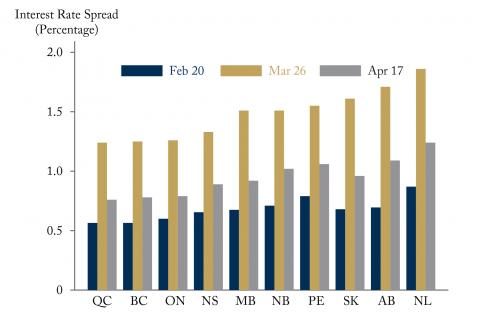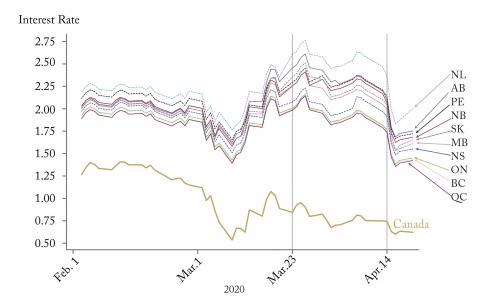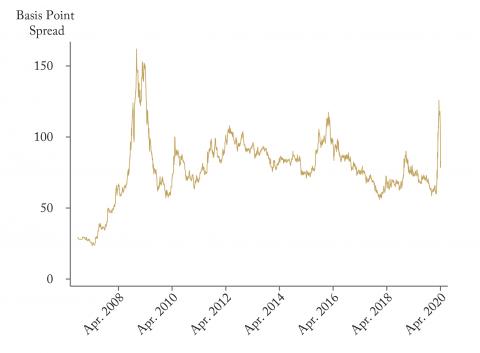From: Kyle Hanniman
To: Monetary Policy Watchers
Date: April 28, 2020
Re: Backstopping provincial debt: How the Bank of Canada made its move
On April 15, the Bank of Canada announced plans to extend its new quantitative easing program to provincial debt. The new Provincial Bond Purchase Program (PBPP) will buy up to $50 billion of provincial bonds with maturities of 10 years or less over a 12-month period.
What precipitated this move? What are its immediate effects?
It was not obvious the Bank would announce the PBPP when it did. The provinces had issued more that $8 billion in bonds the day before the Bank’s announcement, and nearly $20 billion in April to that point, shattering the sector’s daily and monthly records. Even Newfoundland and Labrador, widely reported to be running out of cash, managed to issue $500 million in five-year and 30-year bonds in early April. Why, if provinces were getting money in the door, did the Bank step in?
One widely cited possibility was provinces’ skyrocketing bond spreads. The additional interest rate provinces pay over the federal government always increases during periods of financial distress, as investors seek safety and liquidity in federal bonds. But the scale of day-over-day increases was unprecedented. On March 6, provinces saw their 10-year bond spreads rise 18 to 27 basis points, two to three times higher than the largest increases during the 2008-09 financial crisis.
As Figure 1 shows, resource-based provinces (also reeling from plunging oil prices) were hardest hit, while British Columbia (with its triple-A rating), and Ontario and Quebec (with their relatively liquid debts) fared best. But all provinces saw their spreads increase 66 to 102 basis points in just a month.
But spreads also rose precisely as yields on Government of Canada bonds plummeted, keeping overall borrowing costs low and mitigating the need for central bank intervention (see Figure 2). One can ask, of course, how appropriate spreads of 100 basis points or more are during a pandemic, when the case for sharing risk is so strong. But that is a question best left to the federal government, not the central bank.
A more likely motivation – and one consistent with the Bank’s mandate – was ensuring liquidity. Issuance was spectacular, but almost all of it was going to a small number of large investors, and secondary trading of provincial bonds was thin. These are not markets provinces like to test. They don’t get to choose the maturity or other terms of the bond and often have to pay a premium over unreliable spread indications from secondary markets. Provinces, especially small ones with relatively illiquid pools of debt, often step back from these markets and issue short-term debt until volatility subsides and missing investors return.
This appeared to be the path provinces were taking. There were no provincial bonds issued from February 20 until March 18, when Quebec came to market with a $350 million deal. Shortly after, however, the floodgates opened, despite a continued lack of broad-based demand. What prompted the frenzy?
An initial motivation may have been trouble in short-term markets. The usual well of crisis liquidity – the money markets – had run dry, compelling the Bank to establish the Provincial Money Market Purchase program (PMMP), which began buying up to 40 percent of each of provinces’ short-term debt offerings March 25. (Though less discussed, the provinces’ short-term borrowing also benefited from the Bank’s Bankers’ Acceptance Purchase Facility. This preceded the PMMP and supported money markets by removing pressure from primary dealers’ balance sheets).
The bigger and more enduring problem, however, is the nature of the crisis. We are experiencing the fastest economic contraction on record, with untold potential for market dislocation. Provinces face great uncertainty with respect to borrowing requirements, and whether markets (already looking shaky) will continue to supply them. Logically, therefore, they have been stockpiling liquidity just as fast as investors will allow it. And it does not hurt, of course, that overall borrowing costs are so low.
This was the context in which the Bank decided to act. The provinces were borrowing at a torrential pace, but under extraordinary levels of market and fiscal uncertainty.
The initial effects were dramatic. The provinces’ 10-year spreads fell an average of 21 basis points the day of the April 15 PBPP announcement. As Figure 3 shows, the rise and fall of spreads the past two months has been far quicker than anything seen during the financial crisis, the commodity bust of 2015-16 and other periods of global distress.
But provinces are not out the woods yet. Oil prices plummeted last week and spreads reversed their downward trend. Meanwhile, demand for provincial bonds remains chunky. The PBPP will help stabilize provincial borrowing and finances over the coming year, but we may need additional supports and tools to see provincial borrowers through.
Kyle Hanniman is assistant professor of political studies and a research fellow at the Institute of Intergovernmental Relations, both at Queen’s University.
To send a comment or leave feedback, email us at blog@cdhowe.org.
The views expressed here are those of the author. The C.D. Howe Institute does not take corporate positions on policy matters.
Figure 1: 10-year Provincial-Federal Bond Spreads
Figure 2: 10-year Yields on Federal and Provincial Bonds
Figure 3: 10-year Ontario-Federal Bond Spread
Source: BMO Capital Markets








